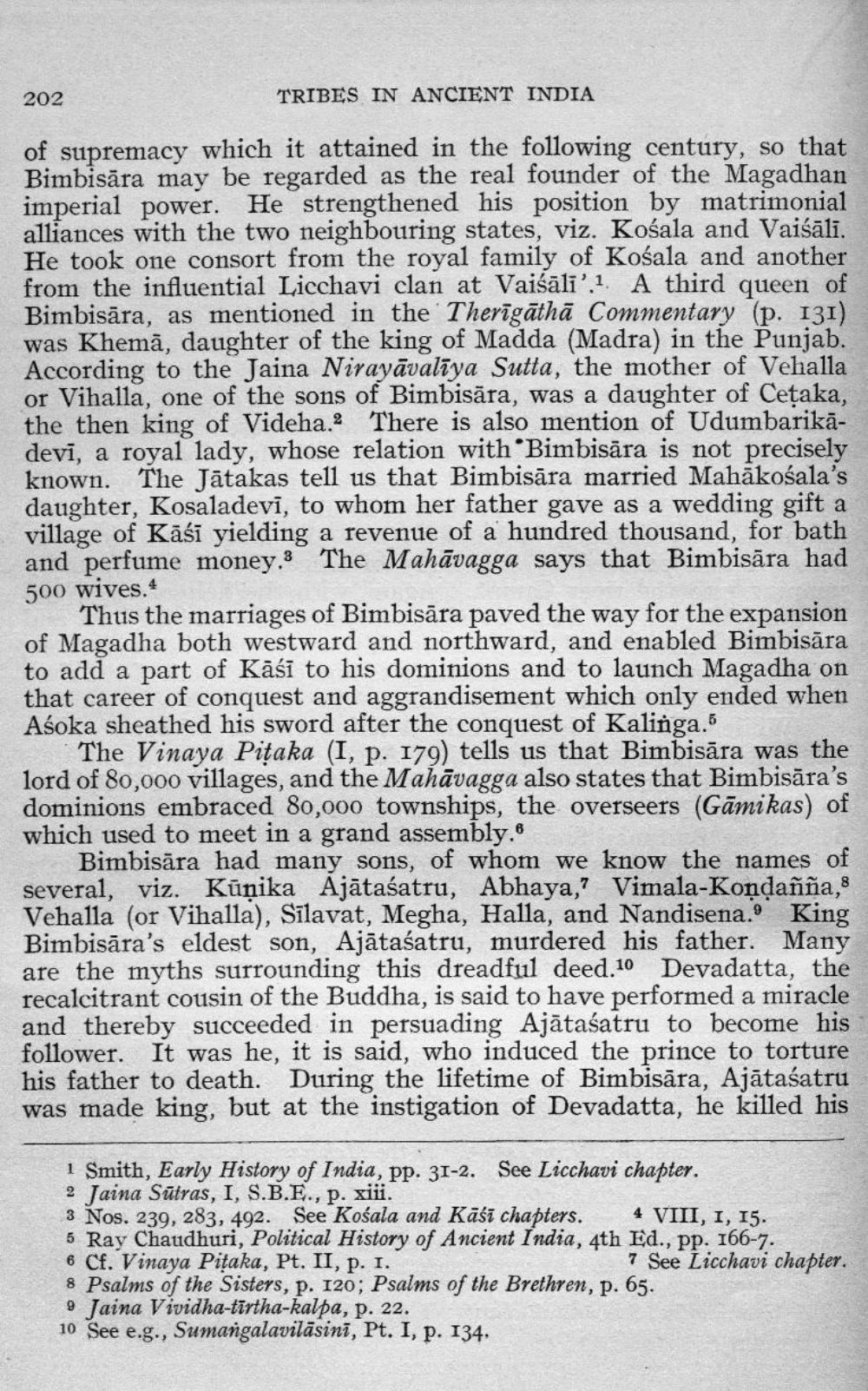________________
202
TRIBES IN ANCIENT INDIA
of supremacy which it attained in the following century, so that Bimbisāra may be regarded as the real founder of the Magadhan imperial power. He strengthened his position by matrimonial alliances with the two neighbouring states, viz. Kośala and Vaiśāli. He took one consort from the royal family of Kośala and another from the influential Licchavi clan at Vaiśāli’.1. A third queen of Bimbisāra, as mentioned in the Therīgāthā Commentary (p. 131) was Khemā, daughter of the king of Madda (Madra) in the Punjab. According to the Jaina Nirayāvalīya Sutta, the mother of Vehalla ar Vihalla one of the sons of Bimbisära. was a daughter of Cetaka. or Vihalla, one of the s the then king of Videha. There is also mention of Udumbarikādevī, a royal lady, whose relation with Bimbisāra is not precisely known. The Jātakas tell us that Bimbisāra married Mahākośala's daughter, Kosaladevī, to whom her father gave as a wedding gift a village of Kāśi yielding a revenue of a hundred thousand, for bath and perfume money.3 The Mahāvagga says that Bimbisāra had 500 wives.
Thus the marriages of Bimbisāra paved the way for the expansion of Magadha both westward and northward, and enabled Bimbisāra to add a part of Kāśī to his dominions and to launch Magadha on that career of conquest and aggrandisement which only ended when Asoka sheathed his sword after the conquest of Kalinga.
The Vinaya Pițaka (I, p. 179) tells us that Bimbisāra was the lord of 80,000 villages, and the Mahāvagga also states that Bimbisāra's dominions embraced 80,000 townships, the overseers (Gāmikas) of which used to meet in a grand assembly.
Bimbisāra had many sons, of whom we know the names of several, viz. Kūņika Ajātaśatru, Abhaya,? Vimala-Kondañña,8 Vehalla (or Vihalla), Sīlavat, Megha, Halla, and Nandisena. King Bimbisāra's eldest son, Ajātaśatru, murdered his father. Many are the myths surrounding this dreadful deed.10 Devadatta, the recalcitrant cousin of the Buddha, is said to have performed a miracle and thereby succeeded in persuading Ajātaśatru to become his follower. It was he, it is said, who induced the prince to torture his father to death. During the lifetime of Bimbisāra, Ajātaśatru was made king, but at the instigation of Devadatta, he killed his
1 Smith, Early History of India, pp. 31-2. See Licchavi chapter. 2 Jaina Sūtras, I, S.B.E., p. xiii. 3 Nos. 239, 283, 492. See Kośala and Kāśī chapters. 4 VIII, I, 15. 5 Ray Chaudhuri, Political History of Ancient India, 4th Ed., pp. 166-7. 6 Cf. Vinaya Pitaka, Pt. II, p. I.
| 7 See Licchavi chapter. 8 Psalms of the Sisters, p. 120; Psalms of the Brethren, p. 65. 9 Jaina Vividha-tīrtha-kalpa, p. 22. 10 See e.g., Sumangalavilāsinī, Pt. I, p. 134,




